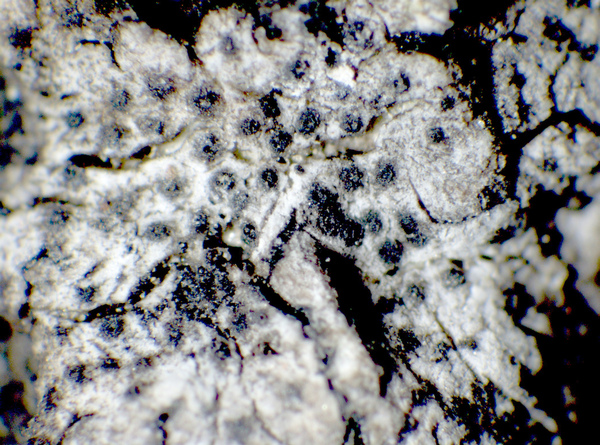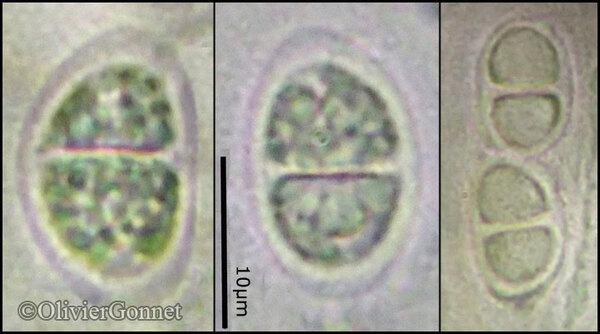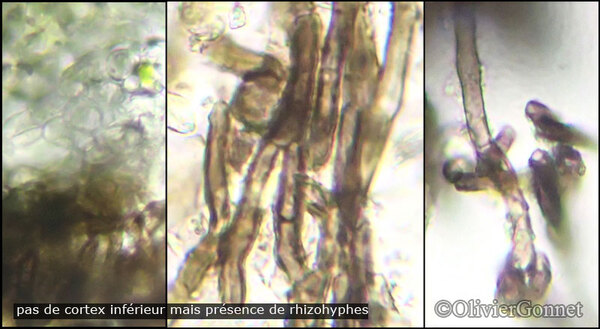Placidiopsis pseudocinerea Breuss
Plant Syst. Evol., 142: 248, 1983.
Synonyms:
Distribution: N - TAA (Breuss 1996b), Lomb (Nascimbene & al. 2021), Piem (TSB 34197), VA. C - Abr (Brackel 2015).
Description: Thallus squamulose, the squamules rounded to slightly lobulate, flattened, smooth, isolated or in small clusters, 1.5-5 mm wide, 0.2-0.4 mm thick, adpressed to the substrate, non imbricate. Upper surface either brownish and epruinose or slightly and partially grey-pruinose; lower surface dark, attached by a dense mat of 4-5 μm thick, dark rhizohyphae. Upper cortex pseudoparenchymatous, 10-30(-40) μm thick, with an irregular epinecral layer; medulla of globose cells, sometimes intermixed with elongated cells; lower cortex well-distinct from the medulla, paraplectenchymatous, the cells brown-walled. Perithecia 0.2-0.35 mm across, laminal, semi-immersed in the squamules, broadly pyriform to globose, without involucrellum. Exciple initially pale, then becoming dark throughout starting from the ostiole, of tangentially arranged, elongate cells; periphyses present around the ostiole, measuring 20-25 x 2-2.5 μm; hymenial gel hemiamyloid. Asci 8-spored, clavate, thin-walled, I-, apically slightly thickened, with a small ocular chamber, 55-65 x 15-22 μm. Ascospores 1-septate, hyaline, ellipsoid to sometimes clavate or curved, thin-walled, (14-)15-19(-21) x (6.5-)7.5-9(-10) μm. Photobiont chlorococcoid (Diplosphaera). Spot tests: cortex and medulla K-, C-, KC-, P-, UV-. Chemistry: without lichen substances. Note: an arctic-alpine, circumpolar lichen found on soil and on moribund bryophytes on siliceous, base-rich or slightly calciferous soil (e.g. on calcareous schist), with optimum near and above treeline; it can be easily confused with Catapyrenium cinereum and is certainly much more widespread through the Italian Alps, also occurring in the Central Apennines.
Growth form: Crustose
Substrata: rocks, soil, terricolous mosses, and plant debris
Photobiont: green algae other than Trentepohlia
Reproductive strategy: mainly sexual
Commonnes-rarity: (info)
Alpine belt: rather rare
Subalpine belt: rare
Oromediterranean belt: absent
Montane belt: absent
Submediterranean belt: absent
Padanian area: absent
Humid submediterranean belt: absent
Humid mediterranean belt: absent
Dry mediterranean belt: absent
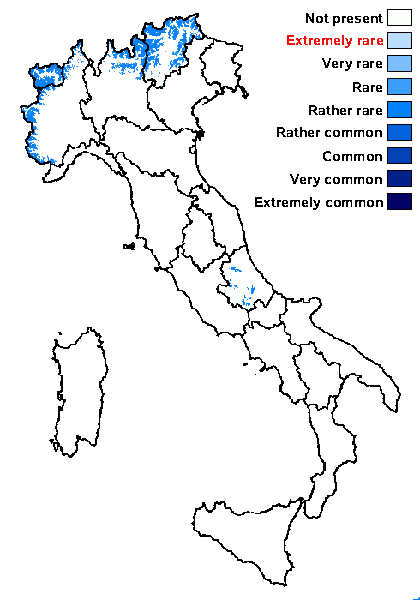
Predictive model
Herbarium samples
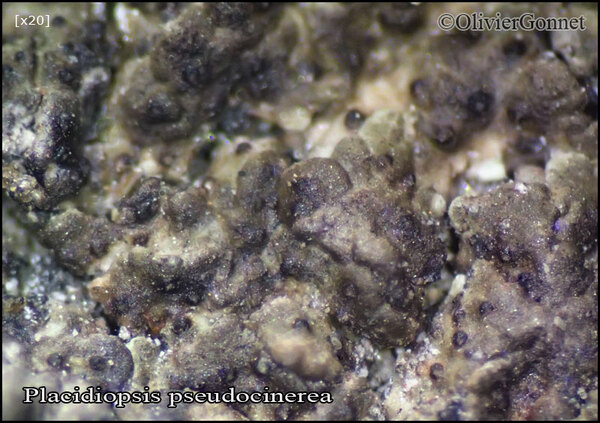
Courtesy Danièle et Olivier Gonnet - Source: https://www.afl-lichenologie.fr/Photos_AFL/Photos_AFL_P/Text_P_4/Placidiopsis_pseudocinerea.htm
France, 4/9/2014 - Bellecombe - Savoie -
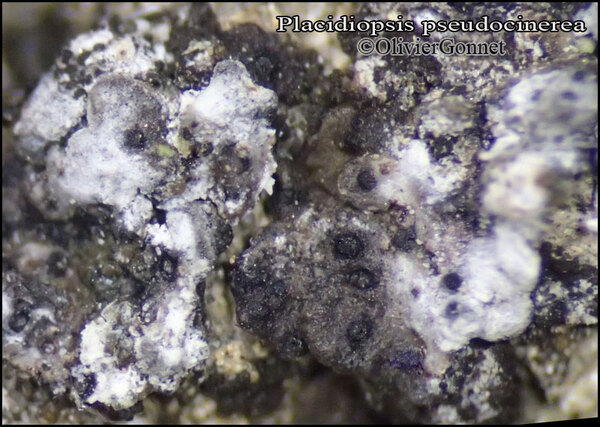
Courtesy Danièle et Olivier Gonnet - Source: https://www.afl-lichenologie.fr/Photos_AFL/Photos_AFL_P/Text_P_4/Placidiopsis_pseudocinerea.htm
France, 4/9/2014 - Bellecombe - Savoie -
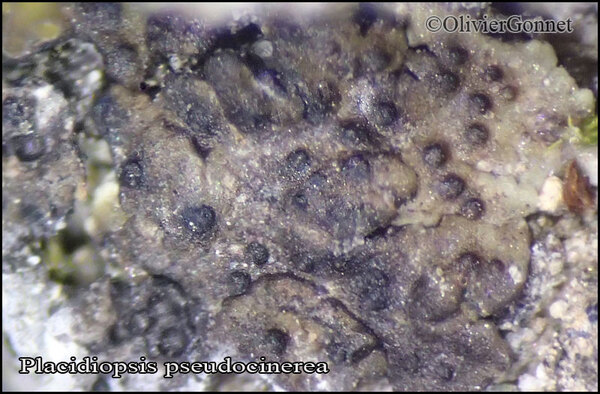
Courtesy Danièle et Olivier Gonnet - Source: https://www.afl-lichenologie.fr/Photos_AFL/Photos_AFL_P/Text_P_4/Placidiopsis_pseudocinerea.htm
France, 4/9/2014 - Bellecombe - Savoie -

Courtesy Danièle et Olivier Gonnet - Source: https://www.afl-lichenologie.fr/Photos_AFL/Photos_AFL_P/Text_P_4/Placidiopsis_pseudocinerea.htm
France, 4/9/2014 - Bellecombe - Savoie -

Courtesy Danièle et Olivier Gonnet - Source: https://www.afl-lichenologie.fr/Photos_AFL/Photos_AFL_P/Text_P_4/Placidiopsis_pseudocinerea.htm
France, 4/9/2014 - Bellecombe - Savoie -
Growth form: Crustose
Substrata: rocks, soil, terricolous mosses, and plant debris
Photobiont: green algae other than Trentepohlia
Reproductive strategy: mainly sexual
Commonnes-rarity: (info)
Alpine belt: rather rare
Subalpine belt: rare
Oromediterranean belt: absent
Montane belt: absent
Submediterranean belt: absent
Padanian area: absent
Humid submediterranean belt: absent
Humid mediterranean belt: absent
Dry mediterranean belt: absent

Predictive model
| Herbarium samples |

Courtesy Danièle et Olivier Gonnet - Source: https://www.afl-lichenologie.fr/Photos_AFL/Photos_AFL_P/Text_P_4/Placidiopsis_pseudocinerea.htm
France, 4/9/2014 - Bellecombe - Savoie -

Courtesy Danièle et Olivier Gonnet - Source: https://www.afl-lichenologie.fr/Photos_AFL/Photos_AFL_P/Text_P_4/Placidiopsis_pseudocinerea.htm
France, 4/9/2014 - Bellecombe - Savoie -

Courtesy Danièle et Olivier Gonnet - Source: https://www.afl-lichenologie.fr/Photos_AFL/Photos_AFL_P/Text_P_4/Placidiopsis_pseudocinerea.htm
France, 4/9/2014 - Bellecombe - Savoie -

Courtesy Danièle et Olivier Gonnet - Source: https://www.afl-lichenologie.fr/Photos_AFL/Photos_AFL_P/Text_P_4/Placidiopsis_pseudocinerea.htm
France, 4/9/2014 - Bellecombe - Savoie -

 INDEX FUNGORUM
INDEX FUNGORUM
 GBIF
GBIF
 DOLICHENS
DOLICHENS


